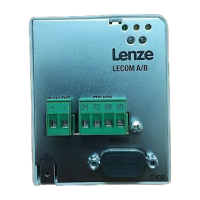Appendix
8-18
L
_^ONMObk
Extended addressing
Another possibility is the direct addressing of parameters by means of expanded addressing.
! CH1 CH2 CH3 CH4 SC1 SC2
The abbreviations have the following meanings:
! The ASCII character ”!” =21
hex
=33
dec
shows
that the expanded addressing is used.
CH1 to CH4 Code number in hexadecimal code:
each character corresponds to a nibble of the
code numbers (CH1 is the highest,
CH4 is the lowest nibble).
SC1, SC2 Subcode number in hexadecimal code:
Each character corresponds to a nibble of the
code number word (SC1 is the highest-
and SC2 the lowest nibble).
The following characters can be displayed in the ASCII code:
ASCII 0 1 2 3 4 5 6 7 8 9 O B C D I F
dec 48 49 50 51 52 53 54 55 56 57 65 66 67 68 69 70
hex 30 31 32 33 34 35 36 37 38 39 41 42 43 44 45 46
Acode number rangefrom 0 to 65535canbeaddressed by means of these characters. Amaximum
of 255 subelements (field elements) can be accessed via one subcode number of each code.
Example:
1002 = ”!03EA00”
Parameter value (V1 to Vn)
Parameter values can be transmitted in four different formats with the following structures:
• ASCII decimal format (VD)
- VK1 VK2 VK3 VK4 VK5 VK6 . NK1 NK2 NK3 NK4
• ASCII hexadecimal format (VH)
H VH1 VH2 VH3 VH4 VH5 VH6 VH7 VH8
• String format (VS)
S VS1 VS2 VS3 VS4 VS5 VS6 ... VS240
• Octet string format for data blocks (VO)
O VO1 VO2 VO3 VO4 VO5 VO6 ... VO240
Buy: www.ValinOnline.com | Phone 844-385-3099 | Email: CustomerService@valin.com

